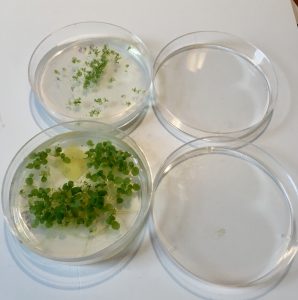 When planning for this year’s biology classes for both remote and hybrid learners, faculty had to get creative and choose labs that worked at home, said biology teacher Michael Edgar. And while teaching hybrid/remote science is different, he said it’s about “letting go of expectations. When I’m with my students, I like to make the best of it and I have had some really nice moments with my classes.”
When planning for this year’s biology classes for both remote and hybrid learners, faculty had to get creative and choose labs that worked at home, said biology teacher Michael Edgar. And while teaching hybrid/remote science is different, he said it’s about “letting go of expectations. When I’m with my students, I like to make the best of it and I have had some really nice moments with my classes.”
In Advanced Biology, a senior elective course, students are growing C-ferns, a regular lab for the class. But this year, students, whether learning remote or hybrid, are growing them at home with kits the biology department put together and mailed out.
“We are looking at the C-ferns’ sex determination,” said Edgar. “We use them as an example of cell signaling, because their sex (hermaphrodite or male) is determined by population density and pheromone signaling by their neighbors.”
Honors Biology classes are growing spores at home and in Edgar’s Molecular Genetics class, home DNA kits were provided by MiniPCR, a company based in Cambridge, Massachusetts. Their DNA Glow Lab kit allows students to use a fluorescent dye to investigate the conditions that influence DNA structure.
During some of the flex periods, students have their Zoom cameras on while they do their lab work. “It’s fun to see them in their home environment working,” said Edgar. “Maybe a student is in their kitchen, heating up water on their stove to use in a lab. We are coming up with new ways of doing things. That creative part is fun and the students, in particular, have been really creative.”